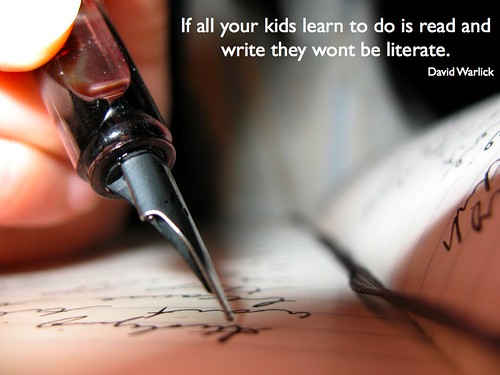
I think I have mentioned that I’ve been working at Kew High School one day a week. It’s been 9 weeks now, and I’m happy and excited to play a small part in connecting the school community with transformative aspects of new technologies . It’s the ideal role for me – introducing Web 2.0 tools, creating and sharing blogs and wikis, helping teachers integrate connective technologies into their curriculum.
This could have been a frustrating experience, considering I’m only at Kew one day a week – trying to catch people throughout a very busy day which happens NOT to be their day for professional development. It could have been, but it wasn’t thanks to the brilliantly supportive and proactive deputy principal, Bernie Lloyd, who organised a lunch in the library (my ‘office’) and lured staff with free lunch. Not only did she bring the sandwiches but she also cut up the fruit and washed the dishes afterwards! How many DPs would do that? She is definitely a linchpin.
That lunchtime session made all the difference. I was introduced to teachers, I pulled out my bag of tricks, gave them a whirlwind tour of Web 2.0 projects and possibilities, and answered questions. I wasn’t sure how much of an impact this would have – although Bernie had assured me that Kew teachers were open to new things – my past experiences had made me somewhat sceptical. Not so at Kew. Teachers gave positive feedback and some immediately arranged meetings to get started. Wow.
I’d started a blog for Kew which Kevin Whitney, Head of Library, named I get to say what’s culture. Just as in my Whitefriars blog, Fiction is like a box of chocolates, I wanted to bring the school community in to assume ownership. Kew’s blog, though, will have a broader base, since it’s not library-centred, and will showcase people’s talents and passions. That’s why I’ve only thrown a few posts in, just to populate it a little, but have stopped posting with the intention of handing it over to the Kew school community. In order to do this I need the collaboration of teachers and their knowledge of the students.
Collaboration with the deputy principal, collaboration with the staff, eventually collaboration with the students. I can’t wait to see the blog in the hands of the Kew High School community.
Thanks, Bernie.

 Photo by
Photo by Photo by
Photo by


 National Gallery of Victoria (Städel exhibition)
National Gallery of Victoria (Städel exhibition) Photo courtesy of
Photo courtesy of 
